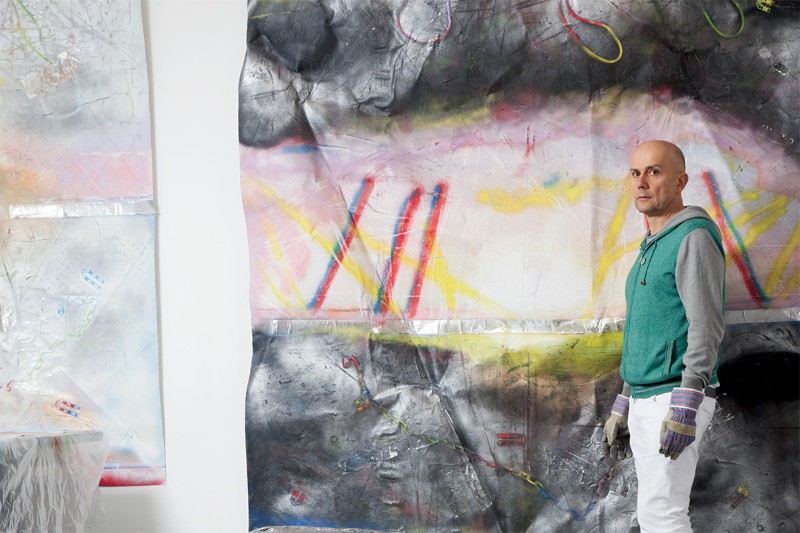Interviewing Marc Quinn about The Toxic Sublime at White Cube, Bermondsey for New Scientist, 15 July 2015
I HAVE always loved Turner and his paintings of the sublime, but we no longer have the pure relationship with nature he had. We can only understand nature by interacting with it, so there aren’t many landscapes untouched by humans.
I’m a city artist so I wanted to make an image of the sublime that was more urban, seen through the goggles of the environmental paradox that if you set off to see something, bit by bit your visit will ruin it. When people say we are going to destroy the planet, we aren’t: we are going to destroy ourselves. The planet will find a new equilibrium.
Each painting in my show uses the same photo I took of a sunrise on a Caribbean beach. I printed it on to canvas and then painted on top. The colours are absurd, of course. There are pinks like those in a sunset, but when you paint them you end up with ridiculous kitschification. Turner’s palette mattered to me, but I was much more influenced by the range of colours afforded by spray paints.
Next, I marked the horizon with tape, then ground lines into the canvas, like map lines or electrical wires or flight paths, and put more tape on. I painted on that, and then started grinding away the paint. You see colours coming through. It’s layered in a very natural way: erosion, if you like.
Then I took the canvases out on to the streets and hammered them into anything to do with water – drains, manhole covers. There’s “Thames Water” indented in one place. You have this image, this element, that’s wide and pure, and then you have what we have done to it. There is a sublime, but it’s one that you have to see through our relationship to it.
But I also wanted to reflect the paradox that if you looked at a nuclear explosion miles away, you would be terrified and horrified, but you would find beauty in it.
So once I bashed the canvas, I stuck it to aluminium, twisted and wrestled with it, kicked and folded it. I wanted it to look like a found object, from off the back of a truck, or the side of a plane that’s fallen out of the sky.
Alongside the paintings are Frozen Waves, sculptures based on the erosion of conch shells by waves, made from stainless steel or white concrete. When a conch erodes, the thickest bit is the last to go. It ends up looking like a wave, the thing that produced it – nature’s self-portrait. The shell’s purpose has become nebulous; it crosses the line between representational and abstract. One of the sculptures is over 7 metres long. The bigger they are, the more it is like being on a beach with a wave coming at you.
The shell is like a scientific demonstration of time. On the back face is the past, the circles made by the accretion of time as the shell gets bigger. And there are patterns: did nature, via erosion, cause dots like a scrimshaw, or maybe they are something people used to record time or make a map? The object’s front face is the present, polished because it’s always in immediate contact with the world.
I used a 3D scanner to make Frozen Waves. If they had been made by hand, they would have felt like a human artefact. This technology is going to change everything: what will matter is not what you have made, but how you have transformed it. If you change the material from which something is made, you look at it in a different way.
I’m working on a 3D scanner for people, to capture movement and print it exactly. In a hundred years, these prints will be like daguerreotypes at the beginning of photography.
Art should reflect the time in which it is made. But maybe some things can’t be understood in the time that you made them. Take the image I created of the genome scientist John Sulston, using his DNA. I like that although it appears abstract, it’s the most realistic portrait in the National Portrait Gallery because it includes instructions to remake the sitter. I like that irony, and the idea that something can be image and object at the same time.

